
After his defeat by Nitta Yoshisada in 1336, Ashikaga Takauji completely restored his forces and secured the support of three powerful clans in Kyushu: the Sōni, Shimazu, and Otomo. In addition, he received significant reinforcements from Shikoku Island under the command of Hosokawa. Having thus strengthened his army, Ashikaga Takauji marched on Kyoto.
The battle unfolded as Takauji advanced along the coast of the Inland Sea. In Tomo, halfway to Kyoto, a military council was held, at which it was decided to attack with two detachments. One unit, commanded by Takauji himself, moved by sea, while the other, led by Ashikaga Tadayoshi, advanced along the coast. The vanguard was commanded by Sonii Yorihisa, who had arrived from Kyushu.
As the two armies advanced eastward, they received significant reinforcements arriving by sea from Shikoku, commanded by Hosokawa. On June 24, Takauji reached Kojima in Bizen, and on July 4, he dropped anchor at Akashi. At the same time, the second army, moving overland, reached Ichi-no-tani, the site of Yoshitsune's glorious victory over the Taira clan in 1184. It was symbolic to spend the night before the battle here.
Unrest in Kyoto
News of Ashikaga's vigorous advance caused alarm among loyalists in Kyoto, as Nitta Yoshisada was forced to retreat under his pressure. Emperor Go-Daigo sent for Kusunoki Masashige and ordered him to support Nitta.
Kusunoki, as an experienced military man, objected to this decision, remembering the Hogen Disturbance. However, his arguments were rejected. He believed that engaging the enemy in open battle was too risky. Instead, he advised Go-Daigo to take refuge on Mount Hiei: Takauji would not be able to resist the temptation to enter the capital, where he could be attacked by the combined forces of monks and samurai, and Nitta would be able to cut off his retreat.
But Kusunoki's wise advice was ignored. He was forced to agree with the emperor's decision. Following the ideals of samurai loyalty, Kusunoki decided to die in battle. Setting off, he was convinced that he would not return. As he left, he told his son Masatsura that he would give his life for the emperor and did so willingly, knowing that one day Masatsura, who was then ten years old, would continue his work.
Troop deployment
The loyalists, threatened by attack from both land and sea, took up their positions. Commander-in-chief Nitta Yoshisada covered the coast between the Minato and Ikuta rivers. Kusunoki stood opposite Ashikaga Tadayoshi's army, with his back to the Minato River.
Tadayoshi divided his army into three parts. He himself took the center, Sonii moved along the coast, maintaining contact with the fleet, and Shiba climbed a hill, threatening Kusunoki's right flank.
First clashes
The first skirmish occurred when Hosokawa's army attempted to land. The loyalists put up fierce resistance: Hosokawa's samurai were thrown back to their boats and forced to sail further east along the shore.
Meanwhile, Nitta was attacked by Soni. Hosokawa soon managed to land his troops at the mouth of the Ikuta River, and Nitta was forced to retreat to repel a new attack. As a result, Kusunoki found himself alone on the opposite bank of Minato.
He could still hold out against Tadayoshi and Shiba, but the landing of Takauji's army put him in an extremely difficult position. Hosokawa, meanwhile, forced Nitta to retreat.
The death of Kusunoki Masashige
On the hot afternoon of July 5, 1336, Kusunoki found himself attacked on all sides. In a fierce battle, he fought to the end, until, covered in wounds, he committed harakiri.
Thus ended the life of Kusunoki Masashige, a samurai who, faithful to his ideals of duty and loyalty, chose death over surrender. With his death, the cause of the loyalists was lost.
See also
-
The Siege of Hara Castle

The Shimabara Rebellion of 1637–1638, which culminated in the siege of Hara Castle, was the last major uprising of the Edo period and had serious political consequences.
-
Battle of Tennoji

The confrontation between Tokugawa Ieyasu and Toyotomi Hideyori during the “Osaka Winter Campaign” ended with the signing of a peace treaty. On January 22, 1615, the day after the treaty was signed, Ieyasu pretended to disband his army. In reality, this meant that the Shimazu forces withdrew to the nearest port. On the same day, almost the entire Tokugawa army began filling in the outer moat.
-
Siege of Shuri Castle

The Ryukyu Kingdom was established in 1429 on Okinawa, the largest island of the Ryukyu (Nansei) archipelago, as a result of the military unification of three rival kingdoms. In the following years, the state's control spread to all the islands of the archipelago.
-
The Siege of Fushimi Castle
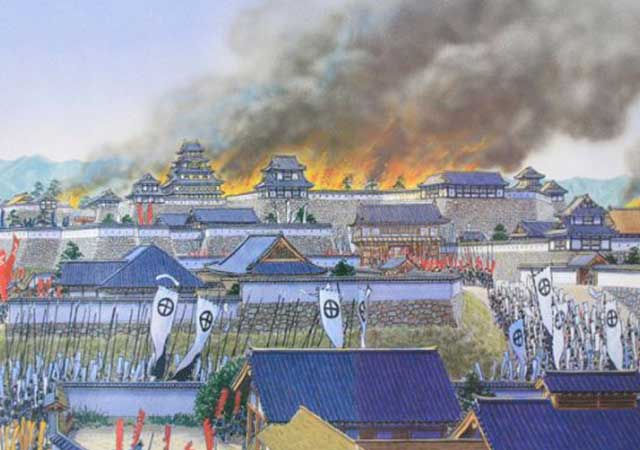
Fushimi can perhaps be considered one of the most “unfortunate” castles of the Sengoku Jidai period. The original castle was built by Toyotomi Hideyoshi in the southeast of Kyoto in 1594 as his residence in the imperial city.
-
The Siege of Otsu Castle
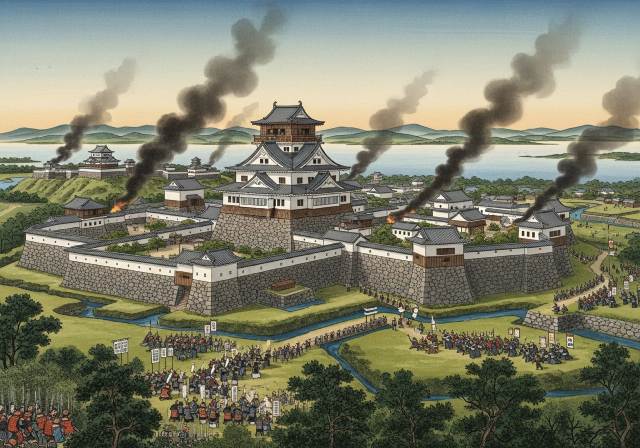
The siege of Otsu Castle was part of the Sekigahara campaign, during which the so-called Eastern Coalition, led by Tokugawa Ieyasu, fought against the Western Coalition, led by Ishida Mitsunari. Otsu Castle was built in 1586 by order of Toyotomi Hideyoshi near the capital Kyoto, on the site of the dismantled Sakamoto Castle. It belonged to the type of “water castles” — mizujō — as one side of it faced Japan's largest lake, Lake Biwa, and it was surrounded by a system of moats filled with lake water, which made the fortress resemble an island.
-
The Siege of Shiroishi Castle
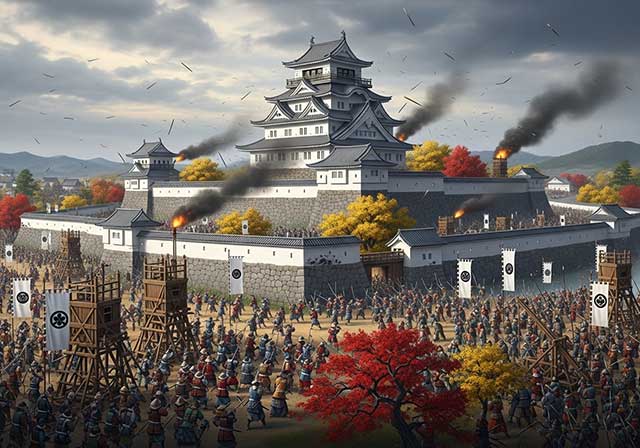
The siege of Shiroishi Castle was part of the Sekigahara campaign and took place several months before the decisive battle of Sekigahara. The daimyo of Aizu Province, Uesugi Kagekatsu, posed a serious threat to Tokugawa Ieyasu's plans to defeat the Western Coalition, and Ieyasu decided to curb his actions with the help of his northern vassals. To this end, he ordered Date Masamune to invade the province of Aizu and capture Shiroishi Castle.
-
The Second Siege of Jinju Castle
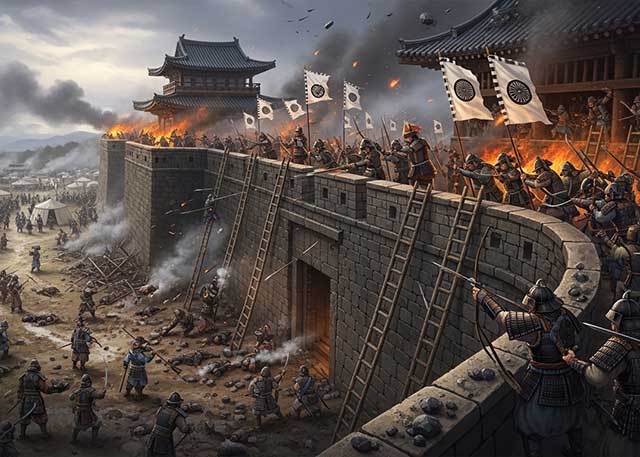
During the two Korean campaigns of the 16th century, the Japanese repeatedly had to capture enemy fortresses and defend occupied or constructed fortifications from the combined Korean and Chinese forces. Among all the operations of that time, the second siege of Jinju Castle is considered the most interesting from the point of view of siege warfare.
-
The Siege of Takamatsu Castle
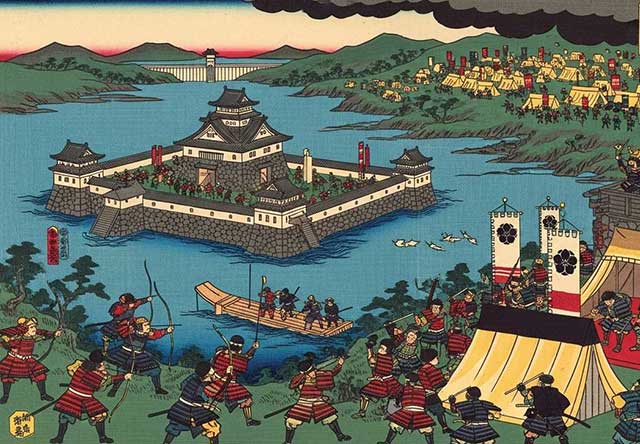
The siege of Takamatsu Castle in Bitchu Province is considered the first mizuzeme, or “water siege,” in Japanese history. Until then, such an original tactic had never been used.

